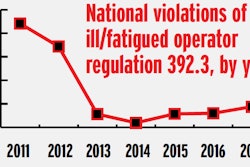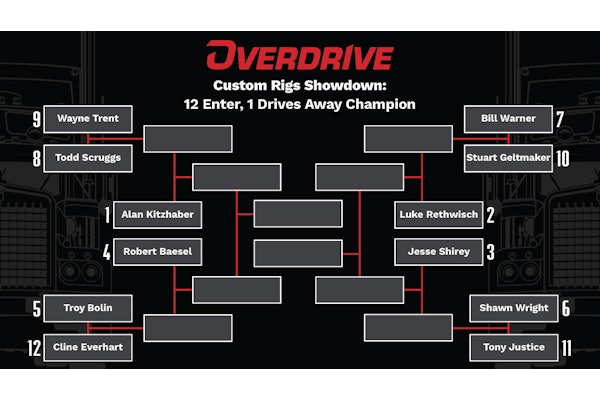
Since the Minnesota State Police infamously developed and implemented a “fatigue checklist” in attempts to provide a way to enforce the vague CFR 392.3 “ill or fatigued operator” regulation, the checklist in 2011 was declared a violation of truckers’ Fourth Amendment rights, which protect against unreasonable search and seizure. The seeming fishing expedition the questions on the checklist represented boggled the minds of many an observer, and for both the trucking industry and enforcement community, it foregrounded the truly subjective nature of fatigue measurement today.
A new U.S. Department of Transportation-sponsored report from the National Academies of Sciences, Engineering and Medicine aims to fully assess current research as regards both measuring fatigue and its relationship to crash risk. Current research on the connection among hours of service, fatigue and accident frequency for truck operators is complicated by the difficulty of measuring driver fatigue objectively, the report’s authors note. The “invasive nature of capturing measures of the amount and quality of drivers’ sleep” also provides barriers to effective research.
Many factors beyond just fatigue or lack of sleep, too, contribute to crashes.

Viewed in the context of somewhat recent developments around fatigue enforcement, the new report, published by the National Academies Press under the title Commercial Motor Vehicle Driver Fatigue, Long-Term Health, and Highway Safety: Research Needs, could represent moves toward providing research to bolster potential future enforcement as it relates to truck operator fatigue.
Since the time of the Minnesota fatigue checklist and associated federal court rulings, 392.3 violations have fallen off considerably in the numbers, according to federal data mined by RigDig Business Intelligence.
The Commercial Vehicle Safety Alliance, with its 2015 revision of the Out of Service Criteria, amended the criteria as they relate to the ill/fatigued operator reg to better reflect road realities: A violation of the rule should only be issued when fatigue is so obvious and severe that it rises to the levels of necessitating an out-of-service order.
CVSA and the Owner-Operator Independent Drivers Association also, however, in 2014 petitioned the Federal Motor Carrier Safety Administration to modify the regulation itself to offer “more clarity and objectivity as to what is considered to be a fatigued condition, such that the driver cannot safely perform the driving task,” CVSA says.
The petition also urged the FMCSA to “provide the necessary guidance, training and tools for enforcement personnel to effectively and uniformly enforce the regulation,” CVSA says.
What the newly released report found, however, is that substantial data gaps limit understanding of all of the factors that affect the health and wellness of truck drivers, including issues around fatigue and sleep. For instance, although considerable data at various levels of private industry and government are collected on drivers who work for large carriers, much less information is available on those who work for small carriers, especially independent owner-operators, the report found.
The authors recommended several improvements in data and research methods by the FMCSA to support a more comprehensive understanding of the relationships between operator fatigue and highway safety and between fatigue and long-term health. The U.S. Department of Health and Human Services and/or the U.S. DOT should fund, design, and conduct an ongoing survey that will allow comparisons of truck drivers to enable tracking of changes in their health status and the factors likely to be associated with those changes over time, the authors noted.
It would be “highly desirable to link the collected data with relevant electronic health records,” the report’s authors go on to say, also casting doubt on the ability of both the current hours of service regulations and driver medical certification procedures to effectively deal with the issue of fatigue.
Hours of service limitations do little to effectively ensure adequate off-duty rest, the authors note, and little evidence exists that required medical exams in the certification process are effective “in determining drivers who are prone to excessive fatigue due to sleep apnea or other medical reasons.”
As Overdrive has reported extensively in the past, “some evidence indicates that medical examiners have been inconsistent,” the report’s authors note, “in the criteria they apply in evaluating the risk of medical conditions that may lead to driver fatigue.”
The report further recommended that FMCSA:
**Increase the availability of relevant data for researchers by incentivizing those who capture driver performance data — large fleets, independent trucking associations, and insurance companies — while ensuring data confidentiality.
**Use particular statistical design and analysis methods to account for factors that confound comparisons between control and treatment groups in crash studies.
**Answer a long list of particular research questions that “should assist FMCSA in understanding the costs and benefits of proposed changes to its policies for the [hours of service] regulations, medical certification, and [voluntary-use resources within the North American Fatigue Management Program].”
As 392.3 violations have fallen off (shown above), CVSA/OOIDA’s petition to FMCSA over 392.3 concluded that, until such time that the agency was prepared to provide enforcement tools/guidance to objectively approach fatigue, the agency should remove the regulation from the books and “aggressively research the development of an objective means for law enforcement to evaluate fatigue (and to take enforcement action) at roadside,” according to CVSA.
Approaching two years after the petition’s filing, FMCSA spokesman Duane DeBruyne says only that it remains under consideration.
“The whole issue of enforcement of 392.3 has cooled down at CVSA as a subject” since the time of the checklist litigation and its conclusion, says Joe Rajkovacz of the Western States Trucking Association, long a regular participant in CVSA’s annual meetings. “There were discussions at one time about where technology at some distant point in the future may develop far enough to determine fatigue, but that was so future forward thinking that pretty much everyone had a problem with it.”
In some ways, the new report underscores such thinking. The research committee behind it also studied the use of various on-board technologies for measuring sleep/fatigue and concluded that despite almost three decades of research on technological innovations for detecting driver fatigue in near real time — with lane deviation and eyelid tracking systems, collision alerting and warning systems, and varying levels of automation — operational strategies for their use are still in the early phases of understanding and application.
At once, “I don’t think 392.3 will go away [entirely],” Rajkovacz says, “because it is a tool that law enforcement still uses where the officer has clearly identified a driver as exhausted — can barely stand up, falls asleep in the squad car, etc. … I get that enforcement is ‘subjective” at that point and the push a while ago was to try and develop ‘objective and uniform standards,’ which are truly elusive. Law enforcement’s point is that without 392.3, they wouldn’t have any power to place such a driver out of service. Tough to disagree with that point of view.”












